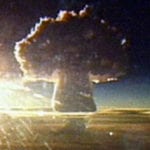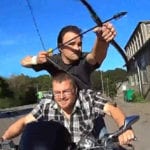 Travel
Travel  Travel
Travel  Movies and TV
Movies and TV 10 Actors Hidden in Your Favorite Movies
 Our World
Our World 10 Science Facts That Will Change How You Look at the World
 Pop Culture
Pop Culture 10 Incredible Female Comic Book Artists
 Crime
Crime 10 Terrifying Serial Killers from Centuries Ago
 Technology
Technology 10 Hilariously Over-Engineered Solutions to Simple Problems
 Miscellaneous
Miscellaneous 10 Ironic News Stories Straight out of an Alanis Morissette Song
 Politics
Politics 10 Lesser-Known Far-Right Groups of the 21st Century
 History
History Ten Revealing Facts about Daily Domestic Life in the Old West
 Weird Stuff
Weird Stuff 10 Everyday Products Surprisingly Made by Inmates
 Travel
Travel 10 Natural Rock Formations That Will Make You Do a Double Take
 Movies and TV
Movies and TV 10 Actors Hidden in Your Favorite Movies
 Our World
Our World 10 Science Facts That Will Change How You Look at the World
Who's Behind Listverse?

Jamie Frater
Head Editor
Jamie founded Listverse due to an insatiable desire to share fascinating, obscure, and bizarre facts. He has been a guest speaker on numerous national radio and television stations and is a five time published author.
More About Us Pop Culture
Pop Culture 10 Incredible Female Comic Book Artists
 Crime
Crime 10 Terrifying Serial Killers from Centuries Ago
 Technology
Technology 10 Hilariously Over-Engineered Solutions to Simple Problems
 Miscellaneous
Miscellaneous 10 Ironic News Stories Straight out of an Alanis Morissette Song
 Politics
Politics 10 Lesser-Known Far-Right Groups of the 21st Century
 History
History Ten Revealing Facts about Daily Domestic Life in the Old West
 Weird Stuff
Weird Stuff 10 Everyday Products Surprisingly Made by Inmates
10 Strange Cultural Effects of Nuclear Weapons
The invention of atomic bombs was one of the most momentous moments in history. Suddenly, nations had the power to vaporize whole cities in an instant. Warfare between the great powers of Earth swiftly became not a matter of victory and defeat but a potential ending of life as we know it. Living under the threat of instant annihilation had an understandable effect on how people lived and behaved.
Here are ten of the unexpected side effects of the existence of nuclear weapons.
Related: Top 10 Disturbingly Practical Nuclear Weapons
10 Bunker Selling
The Cold War between the Soviets and the West was a clash between the competing ideologies of communism and democracy, with capitalism cheering them on from the sidelines. What better way for capitalism to contribute to the fight than to profit from the fear of nuclear weapons? In the 1950s, salesmen began to travel the U.S. selling nuclear bunkers to people as their salvation if the bombs began to drop.
They say advertising works best when you prey on people’s fears of not having your products. According to one vendor of bunkers in 1958, the best approach was to speak to homeowners about the risks of being without a bunker. “We say to people—in their homes especially, and especially if children are there—’What would you do if a bomb went off right now? Where would you go?’” If they suggested they would go into their basement, he would follow up by asking what they would do when the nuclear inferno crashed their burning home on top of the basement. Why not buy a Kidde Kokoon shelter kit for just $3,000 for peace of mind and ride out the end of the world in style?[1]
9 Nuclear Theology
Once you have your atomic bomb shelter, however, there were a number of questions that you would be forced to confront. The U.S. of the 1950s was a deeply Christian country, but what would be the Christian response you had to your neighbors turning up asking to use your shelter during a nuclear war? You might not have enough space in your bunker for everyone who wanted in. Would it be Christian to leave them outside to die?
Time magazine addressed this issue in 1961 in an article titled “Gun Thy Neighbor?” The responses they got were wildly different. One person described how “When I get my shelter finished, I’m going to mount a machine gun at the hatch to keep the neighbors out if the bomb falls.”
Rev. Hugh Saussy thought otherwise. He said, “If someone wanted to use the shelter, then you yourself should get out and let him use it.” Even he seems to have had some doubts about this line of reasoning. “That’s not what would happen, but that’s the strict Christian application.”[2]
8 Nuclear Ethics
While religion tried to deal with the correct response to nuclear weapons, philosophers were also wrestling with their implications. A whole field of thinking was developed that questioned the morality of atomic warfare. Known as nuclear ethics, it considered everything from whether it was right to invest in nuclear bombs instead of welfare projects to whether deterrence of war was a legitimate reason to keep them.
It also led to some interesting thought experiments. In 1981, Roger Fisher, a law professor at Harvard, came up with an idea for preventing nuclear war. “My suggestion was quite simple: Put that needed code number in a little capsule, and then implant that capsule right next to the heart of a volunteer. The volunteer would carry with him a big, heavy butcher knife as he accompanied the president. If ever the president wanted to fire nuclear weapons, the only way he could do so would be for him to first, with his own hands, kill one human being. The president says, ‘George, I’m sorry, but tens of millions must die.’ He has to look at someone and realize what death is—what an innocent death is. Blood on the White House carpet. It’s reality brought home.”[3]
7 Nuclear Plans
Once you have nuclear weapons, it is only natural to look at ways to use them, and not always in an armed conflict. In the U.S., Project Plowshare was developed to look at ways in which nuclear bombs could be used for peaceful reasons. The project was named for a verse in the Book of Isaiah that discusses the coming of peace. “And he shall judge the Gentiles, and rebuke many people: and they shall turn their swords into ploughshares, and their spears into sickles: nation shall not lift up sword against nation, neither shall they be exercised any more to war.”
Some of the ideas suggested seem extraordinary to us today. There was a proposal to dig a new canal through Nicaragua using a series of blasts. It was to be known as the Pan-Atomic Canal. Bombs could also be employed to join underground waterways together to increase water supplies—and no doubt the spread of radiation.
One of the most developed plans was Project Chariot. The idea was to use hydrogen bombs to carve out a new harbor in Alaska using underground detonations. It was never carried out due to protests from locals and the fact that there was little use for a harbor there. Some radioactive waste was buried there as an experiment to see whether it would contaminate the environment. When it was investigated after being forgotten for 30 years, it was discovered, shockingly, that buried radioactive waste will indeed spread radioactivity.[4]
6 Peace Campaigns
Not everyone was happy about nuclear weapons existing at all. In Britain, the Campaign for Nuclear Disarmament was founded by the philosopher Bertrand Russell. While others claimed that the threat of nuclear war was justified by the looming menace of the Soviets, he pointed out, with his usual logic, that it was better to be “Red than dead.”
Mere weeks after the bombing of Hiroshima and Nagasaki, Russell wrote, “The prospect for the human race is sombre beyond all precedent. Mankind are [sic] faced with a clear-cut alternative: either we shall all perish, or we shall have to acquire some slight degree of common sense. A great deal of new political thinking will be necessary if utter disaster is to be averted.” In 1955, he composed the Russell-Einstien Manifesto with other Nobel Laureates for a conference to discuss the banning of nuclear weapons.
At the age of 88 in 1961, Russell served seven days in prison for his part in protests against the stationing of Polaris missiles in Britain.[5]
5 Human Radiation Experiments
The dangers of ionizing radiation were well known by the 1940s. But the dangers of being exposed to dangerous levels of radiation and radioactive fallout had always been limited. If a nuclear war broke out, however, millions or billions would be faced with struggling to survive in it. What was needed was a way to study this matter.
The answer was a series of experiments on people. Some of these are well known, such as stationing military forces near atomic bomb tests to see what the outcome was (often unpleasant). Others, however, were kept fairly secret. In the United States, patients were injected, without their informed consent, with polonium, uranium, and plutonium. One of the patients had suffered a broken arm and leg in an accident. His doctors injected him with plutonium and did not treat the breaks for five days in order to extract bone samples. They also removed 15 teeth to examine them. Other experiments involved giving radioactive elements to pregnant women and feeding children with special needs food containing sources of radiation.
Other nations carried out similarly unethical tests but have been more reticent about revealing the details.[6]
4 Lost Nukes
A nuclear weapon falling from the sky conjures images of sprouting mushroom clouds and instant death. Sometimes though, the bombs fell, and nothing happened. It turns out that flying nuclear weapons on aircraft is an inherently dangerous business—sometimes, during an accident, the bombs are released. Thanks to safety measures, they are unlikely to detonate, but it can still be hard to locate them.
In 1966 near the town of Palomares on the coast of Spain, two planes exploded. One was a nuclear bomber, and the other was the plane refueling it in mid-air. Moments later, four nuclear weapons fell. Three fell on land. Two of those detonated the conventional explosives used to trigger the nuclear explosion and spread radioactive material in the area. The fourth bomb fell into the sea. Dozens of ships and hundreds of divers began to search for it. It was eventually discovered and recovered from a depth of 3,000 feet (914.4 meters).
However, there are an unknown number of nuclear bombs that have been misplaced over the years. One remains missing after crashing down in North Carolina.[7]
3 Godzilla
Popular culture always reflects the society that produces it. Films, TV shows, and books express the hopes, concerns, and fears of the people. With the threat of nuclear war, it is understandable that it crops up again and again in various forms.
In 1955, the film Them! was released in cinemas. It depicts monstrously large ants emerging from beneath the deserts of New Mexico to wreak havoc. We learn that they have been mutated by the atomic bomb tests which took place nearby. This was not the first film to explore the lurking dangers of nuclear warfare in a science fiction setting, though.
Godzilla was released in Japan in 1954 and made explicit reference to Godzilla as a product of nuclear testing. Wherever Godzilla goes, he leaves a trail of radioactive devastation in his wake. He is a stomping metaphor for the dangers of atomic weapons. Given the horrors of Hiroshima and Nagasaki less than 10 years earlier, it is easy to see why Japan would resonate with Godzilla.[8]
2 Nuclear Comedy
There is no matter so grim that you can’t get at least a little laugh out of it. Nuclear war is no exception. The film Dr. Strangelove or: How I Learned to Stop Worrying and Love the Bomb is one of the blackest comedies ever conceived.
In the movie, a rogue military commander sends nuclear bombers on their way toward the Soviet Union. This sparks a crisis when it is revealed that the Soviet Union has a doomsday device that will destroy the Earth automatically if they are attacked. This leads, unlikely as it sounds, to a series of hijinks. It is endlessly quotable, such as when a general and the Soviet ambassador get into a scuffle. The president tries to break them up by declaring, “Gentlemen. You can’t fight in here. This is the War Room!”
The standout character is Dr. Strangelove, a former Nazi obsessed with ever-larger bombs. Because the real physicist Edward Teller shared this penchant for big bombs, he was sometimes referred to as “the real Dr. Strangelove.” When an interviewer mentioned this to him in 1999, he was not impressed. “My name is not Strangelove. I don’t know about Strangelove. I’m not interested in Strangelove. What else can I say? Look. Say it three times more, and I throw you out of this office.”[9]
1 Horrific Fiction
While it is possible to laugh at the nihilism provoked in the face of nuclear destruction, a much more straightforward response was dramatizing the sheer horror of atomic blasts. Threads, shown on the BBC in 1984, must have traumatized an entire nation with the complete dismantling of any hope for survival should a war start.
Throughout the ’70s and ’80s, governments sought to reassure the people that with a few basic techniques, they could protect themselves and their families from the worst of World War III. A simple bomb shelter could be made by digging a trench in the garden or propping some doors against a wall. Painting your windows with white paint might reflect some of the thermal shock of a nuclear explosion. Threads cut through all that with its realistic portrayal of how Britain would cope with even a limited nuclear exchange. Spoiler alert: Not well.
The 1986 animated film When The Wind Blows has a lighter tone but is equally emotionally devastating. It follows an elderly couple in the English countryside who follow all the rules set up by the government when a nuclear war starts. Let’s just say that does not ensure that everything goes well for them. In the United States, people watched The Day After, which aired on ABC in November 1983. This fictional depiction of a nuclear conflict between NATO forces and the Warsaw Pact swiftly escalated into a comprehensive exchange between the United States and the Soviet Union, resulting in the release of a barrage of nuclear weapons.[10]








